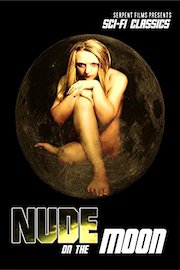-
Genres
-
Release Date2015
-
Runtime1 hr 10 min

Nude on the Moon is a unique blend of science fiction, exploitation, and fantasy that emerged during the 1960s, a time known for its experimental and sometimes risqué cinematic productions. Directed by Doris Wishman and co-directed by Raymond Phelan, the film presents a curious narrative that mixes the imaginative elements of space exploration with the titillating allure of the nudist film genre.
The film opens as we meet the protagonist, a wealthy and determined scientist named Dr. Jeff Huntley, who inherits a sum of money from his uncle. With this newfound wealth, he decides to fulfill his dream: to travel to the moon. Unlike the serious-toned space adventures viewers might expect, Nude on the Moon takes a whimsical and erotically charged approach, reflecting the free-spirited ethos of its era.
Dr. Huntley, along with his colleague, Dr. Nichols, begins an ambitious project to construct a spacecraft capable of taking them to Earth's only natural satellite. The first act of the film details their preparation and launch, paying tribute to the fascination with space travel that was very much alive during the early 1960s, when space race fervor was at its peak. However, contrasted with the real-world advances in technology and space exploration, the film offers only a comically simplified version of these scientific endeavors.
Upon arriving on the lunar surface, Dr. Huntley and Dr. Nichols encounter a world far beyond their expectations, a peculiar garden of delights that flouts all preconceived notions of the barren moonscape familiar to astronomers and the public alike. The duo stumbles upon a harmonious society of moon dwellers who live their lives devoid of clothing, in total harmony with their environment—a veritable Eden on the moon.
The inhabitants, predominantly women, are portrayed as exotic and ethereal beings, embodying the idyllic fantasias of mid-20th-century escapism. They are outfitted with kitschy antennae headpieces, adding a charmingly low-budget aesthetic to their otherworldly nature. These moon dwellers are not depicted as alien creatures but as alluring, human-like figures who engage in leisurely activities reminiscent of those found in contemporary nudist colonies.
The film's central setting, the moon colony, is intended to be a paradise where the natural beauty of the human form is celebrated, and conventional earthly concerns are seemingly nonexistent. Moreover, the environment the moon people inhabit is not the gray, inhospitable realm associated with actual lunar landscapes but rather a lush and tropical place, ironically filmed within the confines of an Earth-based nudist camp in Florida.
As Dr. Huntley and Dr. Nichols interact with this unconventional society, the narrative explores themes such as the clash between scientific curiosity and human desire, as well as the pursuit of utopian fantasies. The astronauts' scientific mission quickly becomes secondary to their immersion in this new culture, which offers a lighthearted commentary on the allure of escapism and the innate human yearning for a simpler, more unencumbered existence.
Visually, Nude on the Moon is characterized by its vivid, albeit low-budget aesthetics. The film's cinematography captures the sub-tropical landscapes with bright, saturated colors, presenting a picturesque backdrop for the otherwise kitschy moon adventure. Practical effects and minimalist set designs contribute to the film's B-movie charm, evoking an atmosphere that is both dreamy and palpably artificial.
Notably, Nude on the Moon undermines traditional narrative structure by sidestepping complex plot developments or character arcs. Its primary focus remains on the visual experience and the novelty of its setting. The film delivers extended sequences that showcase the daily lives and routines of the nudist moon inhabitants, involving leisure activities such as sunbathing, playing sports, and frolicking in the water, all under the guise of exploring a fantastical alien culture.
The dialogue and performances in the film are emblematic of the sexploitation genre, with acting that ranges from earnest to over-the-top. The lines are delivered with the melodramatic flair typical of B-movies, further enhancing the campy and surreal nature of the viewing experience. While character development is minimal, the inhabitants of the moon serve as vessels for conveying the film's central themes of pleasure-seeking and innocence.
Nude on the Moon stands as an artifact of its time, reflecting both the optimism of the atomic age and the growing fascination with sexuality in media. This meshing of sci-fi and sexploitation creates a niche viewing experience that will appeal to fans of cult cinema and those intrigued by one of the more curious offshoots of genre filmmaking.
To those with a taste for the unconventional, Nude on the Moon offers a rare glimpse into a bygone era of moviemaking, when filmmakers like Doris Wishman dared to experiment with story, genre, and societal taboos. Its presence in the annals of cult cinema is affirmed by its unorthodox approach to storytelling, as well as its whimsical representation of human curiosity and hedonism set against the fantastical backdrop of an imagined lunar paradise.